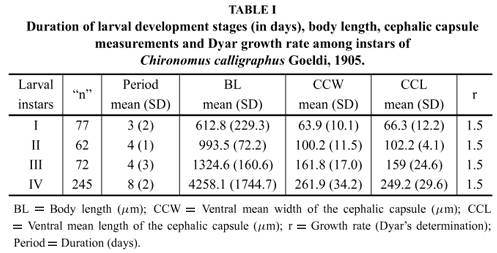Chironomidae larvae are important macroinvertebrates in limnic environments, but little knowledge exists about their biometrics development characteristics. This study aims to describe the immature Chironomus calligraphus Goeldi, 1905 under laboratory conditions by the accomplishment of thirteen egg masses from eggs eclosion to adults emergency, at controlled room temperature (25ºC) and photoperiod (12-12h). Larvae were feed ad libitum with "Alcon Basic - MEP 200 Complex" fish food and commercial dehydrated Spirulina. The postures had a mean length of 9 ± 1 mm (n = 13) and 348 ± 66 eggs. The brownish colored eggs with elliptical shape had length of 160.3 ± 17.7 µm (n = 130), being arranged as an organized string in a pseudo spiral form. The time duration from the first to the four instars were three, four, four and eight days, and the average length of a cephalic capsule to each one of the instars (66.3 ± 12.3 µm, 102.9 ± 22.1 µm, 159 ± 24.6 µm, 249.2 ± 29.7 µm, n = 456) were significantly different (ANOVA, p < 0.001). The Dyar’s Rule showed a constant growth rate, r = 1.5. Our results demonstrated that C. calligraphus is a species with short life cycle, low mortality rate, food adaptability, fast larval growth and easily maintained at laboratory, factors that allowed the use of this native species as a tool for ecotoxicological tests.
aquatic insects; laboratory development; larval instars; life cycle





